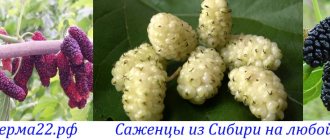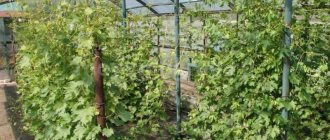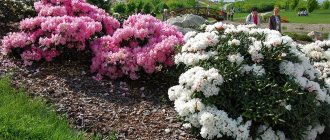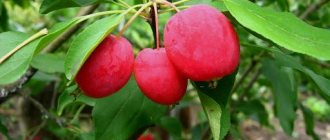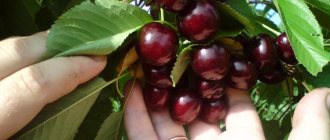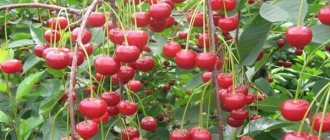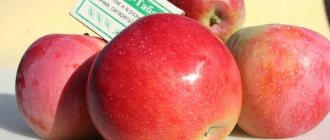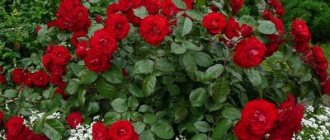Mulberry, mulberry tree or mulberry, is a southern crop and grows naturally in the subtropics of Asia, Africa, North America and the southern regions of Russia. This tree is famous for its extremely healthy, sweet fruits. Modern breeders have obtained varieties suitable for planting in the Moscow region. In this article I will talk about the secrets of planting and growing a mulberry tree in the Moscow region.
Description of the plant
The mulberry tree or mulberry belongs to the Mulberry family. It has a high growth rate at a young age, the tree reaches a height of 10-15 m. Mulberry has a powerful root system and a spreading crown. The leaves are alternate, heart-shaped with a sharp tip and jagged edges.
The fruits are inflorescences of fleshy achenes 2-3 cm long, externally reminiscent of a blackberry. The fruits have a sweet taste and come in white, red, and blue-black colors.
Flowering occurs in April-May, fruits ripen in May-June. At the same time, the mulberry tree has unisexual flowers - staminate or pistillate.
Fruiting begins in the third season of the tree’s life; a full-fledged harvest ripens 5 years after planting. Mulberry is famous for its longevity - the tree usually lives up to 200 years.
In the Moscow region, mulberries are turned into bushes by pruning. This makes it easier to cover the plant for the winter. The mulberry tree can tolerate frosts of at least -30 degrees, provided there is a snowy winter. Frostbitten branches grow back, but freezing of the roots can lead to the death of the tree.
Video Features of cultivation
From the video you will learn how to grow mulberries correctly.
Seedlings grown on a windowsill begin to be hardened off by taking the boxes out into the open air during the day. To avoid burns, seedlings are shaded, protecting them from bright sunlight.
In early May, they begin to sow greens and vegetables that, for some reason, were not planted last month. Here we are talking about such green and vegetable crops as carrots, turnips, radishes, onions (for feathers), parsley, spinach, radish, dill, peas, watercress, cilantro, pumpkin, Chinese cabbage.
Do not spray the garden with concentrated mineral fertilizers or iron sulfate - pollinating insects may be poisoned. If necessary, you can spray with karbofos, but only before the plants in the garden bloom.
In May, it is not too late to vaccinate apple trees, but pruning fruit trees will now have to be postponed until the fall.
It is necessary to carry out preventive treatments of garden plants against diseases: the first spraying is carried out before flowering, the second spraying is carried out immediately after flowering with 1% Bordeaux mixture (100 g per 10 liters of water).
Regular lawn mowing begins. To make mowing easier, you need to stop walking on the lawn for a while. If necessary, weed the lawn turf and apply fertilizer. It's not too late to start a new lawn or herb meadow.
Mulberry varieties
There are about 17 species of mulberries in nature. There are two main types of mulberries grown in Russia – black and white mulberries. Let's consider varieties of mulberry trees suitable for growing in the Moscow region climate:
- Vladimirskaya. Tree up to 6 m high, fruits dark purple, 3 cm long. This mulberry can be formed into a shrub or tree resembling a weeping willow. The variety is frost-resistant; there is no need for pollinators.
- Royal. The variety is famous for its large and sweet fruits, which tolerate transportation well. A tree of medium height is characterized by increased productivity and frost resistance; shelter for the winter is not required, but pollinators are needed, planted nearby.
- Black Prince. The variety is famous for its large fruits, up to 5 cm long, frost resistance and unpretentiousness to the soil composition; it can do without watering, but pollinators are necessary.
- White Honey. It has sweet white fruits, resistance to cold, unpretentiousness to soil, and high yield. But there is also a significant drawback - the fruits have a very short shelf life - 6 hours.
- Black Baroness. It is distinguished by enlarged fruits of a dark purple color, up to 4 cm in length. The variety is characterized by high resistance to cold, increased productivity; one of the disadvantages is the short shelf life of the fruits - 12 hours.
- Staromoskovskaya. The variety is distinguished by tall trees, up to 10 m, sweet blue-black fruits up to 3 cm long.
Benefits of mulberry
As you know, silkworm caterpillars feed on mulberry leaves, with the help of which they obtain highly valuable natural silk. Mulberry wood is often used to make musical instruments.
Juices, compotes, jelly and wine are prepared from mulberry fruits. They are dried and added to confectionery products.
Mulberry berries are widely used in folk medicine; their use improves the condition of many diseases:
- In diseases of the cardiovascular system, shortness of breath and heart pain are reduced.
- Thanks to the presence of many vitamins and microelements, the functioning of the thyroid gland improves.
- The fruits have a choleretic and diuretic effect, relieve inflammation.
- The fruits are used in the treatment of bronchitis, asthma, and improve intestinal function.
- Mulberry juice is used to heal wounds, for stomatitis and colds.
Hypertensive patients and diabetics should use mulberry fruits with caution.
Choosing a landing site
This southern plant prefers windless, well-lit places. It is advisable to find a place on the south side of the garden, which will be protected from the wind by a building wall or fence.
The soil is loose, loamy, with deep groundwater. In the presence of sandy soils, arrange an additional drainage layer of small fragments of brick.
Wetlands and low-lying places are contraindicated for mulberries; in conditions of dense and waterlogged soil, the plant dies.
Preparing for landing
It is recommended to plant a mulberry tree in the Moscow region in the spring, before the sap begins to flow. The selected area must be cleared of weeds and dug up with the addition of minerals and organic matter. Planting holes measuring 80*80*80 cm are dug in the fall. Peat is added to heavy soils.
Three-year-old seedlings that have already borne fruit are chosen, since it is impossible to determine the sex of the plant before fruiting. Fruits are produced on female trees; male trees are planted nearby for pollination and for landscaping in the garden. It is advisable to purchase seedlings with a closed root system, without signs of disease.
Reproduction
Growing mulberry in the Moscow region can be done in various ways - seeds, sprouts, grafting, cuttings. Planting requires seeds from the current harvest. Cleared of pulp, they are sown in fertile soil already in February. The room temperature should be maintained at 20⁰ C. And after warm days arrive, young plants are transplanted into beds. The mulberry is transferred to its permanent habitat only the next year. You should be aware that when propagated by seeds, some properties of the variety may not be fully inherited.
Landing
- A drainage layer is laid out at the bottom of the pit, then a bucket of compost or humus is poured out.
- Drive a peg into the center of the hole to secure the seedling.
- Place the seedling in the hole. If it was with closed roots, then it is planted using the transshipment method. If the seedling has bare roots, then straighten the roots.
- The seedling is covered with soil, to which 150 g of mineral fertilizers are mixed.
- Compact the soil and water. In this case, it is necessary to slightly deepen the root neck.
- Mulch the root zone of the seedling with straw, sawdust or dry leaves, and tie the seedling to a support.
Care
Caring for mulberries is very simple; even a novice gardener can handle it. By following the basic rules of agricultural technology, you can get a good harvest of healthy fruits.
Watering
Young seedlings are watered as the soil dries out. Adult plants are watered only during the summer drought. After watering and rain, the tree trunk area is loosened, weeds are removed, and then mulched with straw.
Top dressing
After spring planting, seedlings are fertilized in the summer with minerals and organic matter, but in minimal doses, otherwise the plants will produce unnecessary root shoots. Mature trees are fertilized twice a season - in spring and autumn, alternating organic fertilizers (manure and wood ash) with mineral complexes (nitrogen and potassium).
Trimming
In early spring, before the sap begins to flow, sanitary, rejuvenating and formative pruning is carried out. To form a bush, several strong shoots are left. To form a trunk, use one shoot as a trunk. The root shoots are removed. To create a weeping mulberry, thin out the crown and remove excess shoots.
Reproduction
Mulberries can be propagated in the following ways:
- Seeds. This is too complicated and time-consuming method, which is used only by breeders.
- Cuttings. This method is also quite complicated, and it is used by breeders.
- Layerings. The most accessible way for gardeners to propagate mulberries. The main plant is pruned to a stump; after a year, powerful growth is formed. The shoots are bent to the ground, hilled up and watered several times during the summer. By autumn, ready-made seedlings are formed, which are separated and planted.
- Graft. The grafting method is used to produce two colors of berries on one tree or to create a weeping dwarf tree.
Diseases and pests
Mulberry is highly resistant to various diseases. If the planting site is chosen correctly and the tree is properly cared for, it will not get sick. But if for some reason signs of disease appear, the plant must be treated with an appropriate fungicide.
If harmful insects appear - cockchafer, mole cricket, wireworm, white butterfly, spider mite, the affected branches must be cut and burned, and the trees must be treated with insecticides.
The greatest danger to the harvest comes from birds that love to eat sweet berries. To protect against feathered pests, trees with fruits are covered with fine nets.
Wintering
In late autumn, the root zone of the mulberry is mulched with a thick layer of straw, fallen leaves or spruce branches, the side branches are tilted to the ground, covered with spanboard, and secured with bricks. After the onset of spring warmth, the shelter is dismantled.
Disease and pest control
White Honey is immune to brown spot. However, it is susceptible to infection with powdery mildew, which can appear during dry periods as a white coating on the leaves. Spraying trees with a fungicide solution helps against it. The procedure is repeated a week later. As a preventive measure, work can be carried out in early autumn using colloidal sulfur, Fundazol or Bordeaux mixture.
Important! Many pathogens live and overwinter in fallen leaves. Therefore, in the fall it is collected and necessarily burned.
Bacteriosis usually affects young shoots. Irregular spots appear on the leaves. Over time, they turn black and the leaves fall off. Elongated brown spots appear on the shoots. For the fight they choose “Fitoflafin”, “Gamair”. The best prevention is not to overwater the mulberries.
The most common virus that affects mulberry trees is small leaf curl. It is spread by sucking insects (thrips, aphids, mites, etc.). A characteristic feature is wrinkling, nodularity between leaf veins, and shortened cuttings. Gradually, the leaves wrinkle along the veins and turn inward. Young branches weaken and become deformed, internodes are shortened. New leaves are pale, brittle and rough. Productivity drops sharply. A sick tree can rarely be cured. “Gamair” and “Fitoflavin” are suitable for fighting. The best preventative measure is whitewashing tree trunks with lime.
To prevent the appearance of gum, mechanical damage to the bark is cleaned, disinfected with a 1% solution of copper sulfate and treated with putty made of nigrol and sifted ash (7:3).
You might be interested in reading how to plant mulberries.
The tinder fungus parasitizes the mulberry, destroying its wood. If you don't fight it, it can destroy an adult plant in a few years. To prevent the appearance of mulberries, the cut areas and wounds are treated with garden pitch, iron sulfate, and paint based on natural drying oil. If a mushroom appears on a branch, it is safer to cut it down. It is cut out from the trunk, capturing part of the wood. The cut site is treated with copper sulfate (5% solution) and covered with a mixture of lime, clay and cow dung (1:1:2). Mulberry caps contain spores, so they must be burned.
You can protect a tree from attack by the mulberry moth caterpillar by treating it in early spring, when the buds are just beginning to swell, with Chlorophos.” "Aktelik" will help against ticks. Against the beetle (chafer) - April treatment of the crown with “Aktara”, “Prestige”, etc. At the same time, they try to get the drug on the trunk and root collar.
For comprehensive protection (both against diseases and pests), tank mixtures are used. The drug from “Aktara” and “Horus” is prepared to prevent the appearance of flower beetle, scab, powdery mildew, etc. Trees are treated in the spring during bud break. Spraying mulberries after flowering with a tank mixture of "Aktara", "Match" and "Skor" will help simultaneously against the sawfly, leaf rollers, wandering larvae of the Californian scale insect, aphids, scab, powdery mildew, Alternaria, etc. During prolonged rains add "Horus."
So, white mulberry Honey is an unpretentious variety with decent yield. Despite the poor keeping quality of the fruit, it is invariably popular among amateur gardeners due to the dessert taste of the berries.
Reviews from gardeners
Evgeniy, 56 years old, Podolsk:
I have been growing mulberries in my garden for many years. I have the Black Prince variety. Caring for it is simple; we trim it to a bush, so it can withstand the winter easier. The productivity is high, we even make wine. Berries help with heart diseases.
Elena, 38 years old, Sergiev Posad:
Five years ago, we planted mulberries of the Black Baroness variety in the garden. A berry is good for everyone, both large and sweet, but you need to eat it as soon as possible, it does not store for a long time.
Nikolay, 65 years old, Orekhovo-Zuevo:
10 years ago I planted mulberry trees on the plot. They began to bear fruit in the third year. The berries are black, sweet, the yield is good, but the birds flock to them, so we have to put up scarecrows and cover the trees with netting.
Mulberries in the Moscow region: how to choose a variety and get a harvest
Adding an article to a new collection
Some people love traditional fruit crops, while others chase wonders. And if you consider yourself to be one of those who wants to grow something exotic on your plot, why not buy a mulberry seedling?
“So it’s a blackberry!” – many will exclaim when they see mulberries (mulberries). However, despite all the external similarities, this is a completely different plant. It's not even a shrub, but a deciduous tree. He likes warm and even tropical climates. But if you really want to, it’s quite possible to grow mulberries in the Moscow region.
